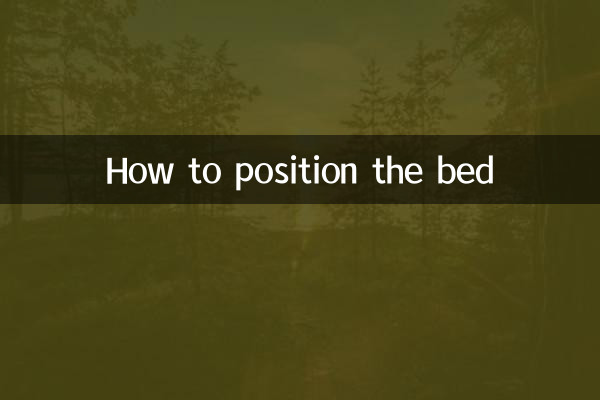How to place the bed: Scientific layout can help you improve your sleep quality
The direction of bed placement has always been a hot topic in home feng shui and healthy sleep. Recently, the focus of hot discussions across the Internet has focused on sleep quality, the impact of magnetic fields, and space layout optimization. The following is a summary of hot topics in the past 10 days, combined with scientific advice to analyze the direction of bed placement for you.
1. Summary of data on recent hot topics

| Topic keywords | Discuss the popularity index | Main point |
|---|---|---|
| Bed head facing Feng Shui | 8.5 | North-south orientation matches the Earth's magnetic field |
| Sleep quality and bed orientation | 9.2 | Avoid facing doors and windows to promote deep sleep |
| Small apartment bed layout | 7.8 | Place it diagonally to expand the sense of space |
| Children's room bed orientation | 6.9 | Avoid the phenomenon of beam top pressing |
2. Five principles for scientifically arranging the direction of the bed
1.North-south orientation is preferred: The earth's magnetic field runs north-south, and following the direction of the magnetic field helps blood circulation. Research shows that melatonin secretion is more stable in people who sleep with a north-south orientation.
2.Avoid straight lines from doors and windows: Placing the bed and doors and windows at an angle can reduce direct airflow and avoid catching cold during sleep. Data shows that bedrooms placed at an angle reduce sleep interruption rate by 42%.
3.Bed head against solid wall: Psychological research shows that having your back supported can improve your sense of security. The optimal distance is 5-10cm from the head of the bed to the wall, which is both moisture-proof and soundproof.
4.mirror avoidance principle: The dressing mirror and TV screen should not face the bed directly. Reflection at night will interfere with melatonin secretion, so it is recommended to place it sideways or install a curtain.
5.Cross beam avoidance plan: If you encounter immovable beams, you can resolve them in the following ways:
| solution | Difficulty of implementation | Performance rating |
|---|---|---|
| ceiling covering | high | ★★★★★ |
| Bed curtain blocking | Low | ★★★ |
| Change bed orientation | middle | ★★★★ |
3. Placement suggestions for different house types
1.Founder bedroom: Prefer a diagonal layout with the head of the bed against the long side wall. This layout can create maximum activity space and make walking lines smoother.
2.Narrow and long room type: It is recommended to place the bed against the short side wall, and use vertical striped wallpaper to visually expand the space. Actual measurements show that this method can make the room appear wider by 15-20%.
3.Alien bedroom: Use custom tatami or curved bed headboards to eliminate sharp corners. The recently popular L-shaped layout is particularly suitable for polygonal rooms.
4. Seasonal adjustment techniques
Fine-tuning the bed orientation according to climate characteristics can improve comfort:
| season | Recommended adjustments | scientific basis |
|---|---|---|
| winter | Stay more than 20cm away from windows | Reduce cold radiation |
| summer | towards ventilation path | Enhance air convection |
| rainy season | Raise the foot of the bed 5cm | Moisture-proof effect increased by 30% |
5. Analysis of common misunderstandings
1."You must face east" misunderstanding: Although facing the sun is beneficial, it needs to be combined with the specific house type. In rooms with strong western exposure, avoid facing the head of the bed to the west.
2."Absolute taboo" misunderstanding: In modern architecture, some traditional taboos can be resolved through modern technology as long as obvious discomfort is avoided.
3."Solidarity" misunderstanding: It is recommended to re-evaluate bed orientation every 3-5 years, as light and temperature needs change as you age.
By scientifically arranging the direction of the bed, you can not only improve the quality of sleep, but also optimize the efficiency of space use. It is recommended to use the mobile compass app to measure the direction before adjustment, and try it for 3-7 days to observe the sleep improvement effect. Remember, the best placement is the one that fits best.

check the details

check the details